|
Phases >
Business Development >
Pre Engineering >
Engineering >
Transition >
Support
The Engineering Phase is supposed to be the hands on stage of the process. In this phase,
all the definitions previously held are reviewed so it can be put in practice.
The milestone for this phase is the release of a set of stories to the Operations and Support team.
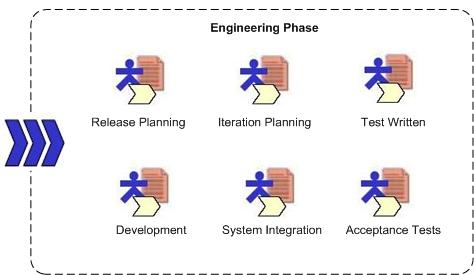
|
|
Release Planning:
The objective of the Release Planning is to plan all the customizations, features, corrections
that should be delivered in the next release of the product. This planning can be reviewed and
modified in case priorities change during the project.
The development team uses the stories written before to estimate implementation effort.
The practice 'the planning game' describes that a release should have stories that adds value
to the customer business, in other words, stories of higher priority to the customer, in accordance
with the Deployment Manager priorities. The development team then estimates how many stories will be
implemented in the following iterations based on their velocity and on each story complexity.
The Release Planning has to consider effort estimates and risk factors. Stories of high risk should be
scheduled in the first iterations to mitigate risk. Research stories are also high risk stories, because
there is not enough information on how to implement them.
|
|
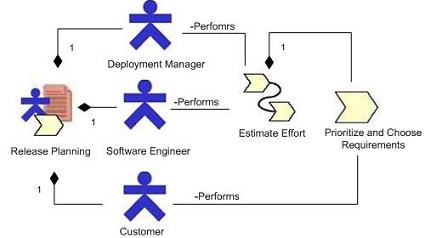
|
|
Top >>
|
|
Activities
|
|
Estimate Effort
|
|
Objectives: Estimate effort to implement activities of current release.
|
|
Steps: Choose stories to be released and estimate effort needed
to implement each story.
|
|
Choose and Prioritize Requirements
|
|
Objectives:
This activity is part of the work definition Estimate Effort and as so its objective is to choose and
prioritize requirements that will be in the next release.
|
|
Steps: Review and validate priorities. Choose high priority stories.
|
|
|
|
Iteration Planning:
This worlflow is about planning the next iteration. In the same release we can have several iterations.
In the Iteration Planning the estimates defined in the release planning are reviewed and it is
defined which and how many stories will be implemented in the next iteration.
The analysis of each story individually is part of the iteration activities. Each story is break up
into small tasks. During this analysis, if the story is too large to estimate the team can decide to
divide it in more than one story. Research stories can also be created when there is not enough
information to estimate effort for it.
The development team should try to improve effort estimates defined on the release planning
The Deployment Manager is the one to determine the set of stories to be implemented. This whole process
should be guided by 'the planning game' practice. The software engineer is responsible for defining implementation
effort of each story, while the customer along with the deployment manager assign priority levels to each of the
stories based on their business value.
Priorities should be based on customer priorities and project priorities. In other words, customers set their
priorities and deployment manager set priorities for stories according to customer importance.
|
|
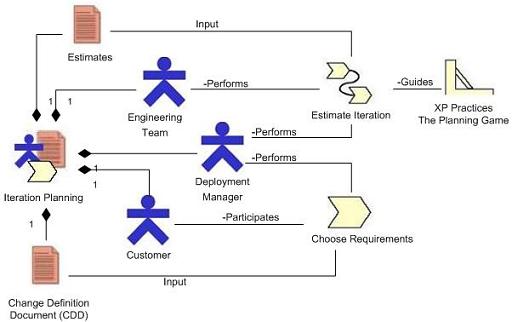
|
|
Top >>
|
|
Activities
|
|
Estimate Iteration
|
|
Objectives: Analyze each story scenario and estimate effort to implement activities for the iteration.
|
|
Steps: Estimate effort needed to implement each story.Check if necessary to divide a story
or to create research stories.
|
|
Choose Requirements
|
|
Objectives: This activity is part of the work definition Estimate Effort and as so its objective is to choose and
prioritize requirements that will be in the next iteration.
|
|
Steps: Choose requirements that will be implemented in the next iteration.
|
|
|
|
Test Written:
In this workflow, functional tests for the system should be written. Functional tests are produced
from the requirements defined in the Change Definition Document (CDD). The CDD document is the input
for the key activity of this workflow. In this approach, tests should be written by a Test Engineer
assisted by a Software Engineer. The customer does not take part in the Test Written on site.
In this approach, relationship with customers and their location generally makes it impossible to be
held with the customer on site.
The output of this workflow is the Test Scenarios that will be used to validate system features. These
scenarios can be automated or not, it is up to the Engineering team. The main objective of the functional
tests is to test the most complex functionalities of the system, while unit test validates class methods.
|
|
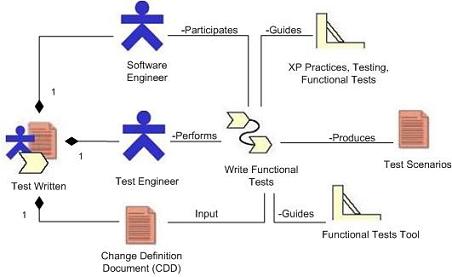
|
|
Top >>
|
|
Activities
|
|
Write Functional Tests
|
|
Objectives: Get the test scenarios written based on the CDD document so system can be
tested.
|
|
Steps: Analyze requirements. Decide if tests should be automated or not.
Write tests based on the decision made.
|
|
Artifacts: Test Scenarios
|
|
|
|
Development:
The Development workflow includes activities such as design, implementation
and test of a unit of work.
One of the main objectives on the Customization of Software Products should be to
avoid changes to core functionalities of the product.
Therefore, design definitions that can affect the architeture and business logic of the
system should be out of scope from the customizations standpoint.
When changes to system core are needed, there must be a general agreement beteween fields operation team
and product development team in the sense that individual efforts to each customer is minimized.
If a change to the product is a common need it can be shared among customers and can possibly
be allocated to the product development team.
It is up to the Field Operations team to decide whether to wait for a new version of the product
or to perform the adaptations to the current version in order to fill customer needs.
Changes should be designed, specified, implemented and tested. The specification should be
performed using unit tests.
If it is desired to control all the changes details it can be added to the design document
the relevant code changes (e.g class and methods changed, changes to database, triggers, procedures and tables).
|
|
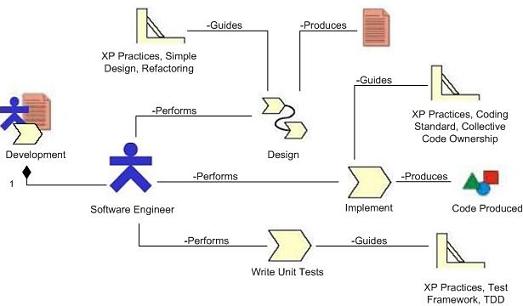
|
|
Top >>
|
|
Activities
|
|
Design
|
|
Objectives: Get a better understand of the change to be implemented and clarify design aspects.
|
|
Steps: Understand change. Model feature.
|
|
Artifacts: Design Document
|
|
Perfom Unit Tests
|
|
Objective: Specify feature and test efficiently the unit of work implemented.
|
|
Steps: Write unit tests. Execute Test.
|
|
Implement
|
|
Objectives: Build feature according to design decisions.
|
|
Steps: Perform changes needed according to spefications on the design document. Implement new class or modules when necessary.
|
|
Artifacts: Code and Design Document(updated)
|
|
|
|
System Integration:
Continuous Integration of the code to the repository should happen often and ideally changes
should never wait more than one day to be submitted to repository.
Each sofware engineer is responsible to integrate their own code and whenever possible
break features in logical units. Integration should happen when 100% of the unit tests are
successfully execute or when a part of the feature is done.
System integration requires functional testing. This means that all the changes that are
integrated to the repository have to be fully tested by the software engineers through their unit tests
to prevent errors on features that were already tested.
|
|
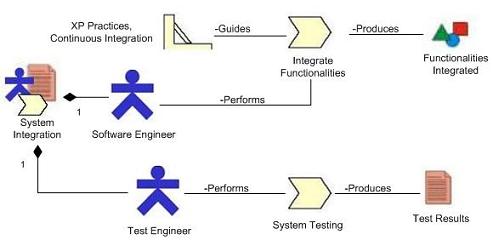
|
|
Top >>
|
|
Activities
|
|
Integrate Functionalities
|
|
Objectives: Perform integration of recents changes so functional tests can be performed.
|
|
Steps: Submit changes to repository and run a build of the brand new changes.
|
|
System Testing
|
|
Objectives: Test system functionalities.
|
|
Steps: Perform tests according to Test Scenarios.
|
|
Artifacts: Result Sheet.
|
|
|
|
Acceptance Test:
After your system testing proves successful, the customer must perform acceptance testing,
a process in which they determine whether the system truly meets their needs
This test stage is critical to the success of the system because it is during
this stage that you determine if the system is suitable for release to your user community
Acceptance tests are created from user stories that are selected in every new iteration and translated
to acceptance test. A story can only be closed if all test cases related to it were successfully performed.
Test Scenarios are supposed to give guidance during this activities and it can be automated or not.
The test results can be reported on a result sheet or on a change control tool.
Acceptance tests are also called black box tests and can be used as regression test that precedes release
to production environment.
|
|
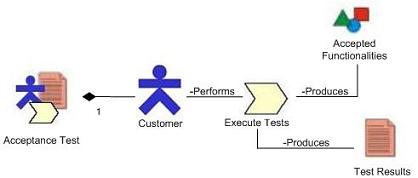
|
|
Top >>
|
|
Activities
|
|
Perform Tests
|
|
Objectives: Allow customer to validate functionalities already implemented.
|
|
Steps: Perform tests and report results.
|
|
|